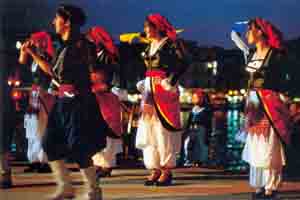

|
THE GREEK MUSIC The actually Greek music is not existing that long and there is the traditional and the modern music. Both kinds are very popular in Greece. There is no other country with so many singers. For generations music was the form of expression for war and peace, rich and poor, sorrows and joys. Feast with music has been existing already in the ancient times. During the Byzantine period a music style was developed, which was spread all over Asia Minor. From this style the Rembetiko-music was deduced, it was brought to Greece due to the exodus. The main instrument is the bouzouki, which had at that time six strings. In the 1960ies it changed to eight strings. So in some way Rembetiko-music is the origin of the nowadays Bouzouki-music. Completely different to the common Greek music is Cretan music - much wilder and unruly. In complicated 7/8 or 9/8 measure, sometimes monotone and archaic, sometimes ecstatic the melodies are twirling out. The oriental influence can not be missed to listen. The main instrument is the lyre, which is a traditional three chord string instrument made of mulberry wood. It is accompanied by the lauto, a kind of lute and the tambouras, the bouzouki. Very often vocals are added and then it is an dialogue between voice and lyre. The verses consist of so-called mantinades, two lines with 15 syllables, with a lot of joke and spirit in it, sang very often spontaneously. There are for every case mantinades, from the age of a child the Cretans start to rhyme.
In the country side and up in the mountains people still are using the askomantoura, a traditional double-flute. CRETAN DANCES While dancing the Cretans express their feelings and soul, not only their joys, also their sorrows, rage and pain are appearing the surface.
Sirtos: these fast round dances in typical 7/8 measure are danced all over Greece in quite different ways, also they do have different names, depending on the area. Sirtos in Hania e.g. is called Haniotikos, in Rethymnon it is called Rethymniotikos: the dancers are creating an open circle and touch each other with hands and shoulders. The first in the row can decide, what will be danced and can present all his dancing skills. By the way, the world famous sirtaki is not a traditional Cretan dance. It was invented by Mikis Theodorakis for the movie Zorbas, the Greek with Anthony Quinn and is a simplified version of the Sirtos Pentozalis: (five step) is the most common known Cretan dance originated in the isle's east, the roots probably are going back to the Minoan period. It is similar to the sirtos, a couple of dancers create a cue, touching each other at the shoulders and start with an unmoved upper part of the body very slowly the quite complicated dance steps. The first one is again the one who is leading. Step by step the dance becomes quicker and quicker, passion is becoming more intensive and than the leader goes into the middle to make a solo. So the next one in the cue takes over the leadership. Sousta: is the island's only kind of dance, which is done by couples and has its origins probably in Rethymnon. Mostly it is danced at wedding celebrations. |
© SCI 2003 - 20XX // all rights reserved
 It is very common that one single dancer appears at the dancing floor and is giving a very intensive show, also elderly Cretans can be watched.
It is very common that one single dancer appears at the dancing floor and is giving a very intensive show, also elderly Cretans can be watched.